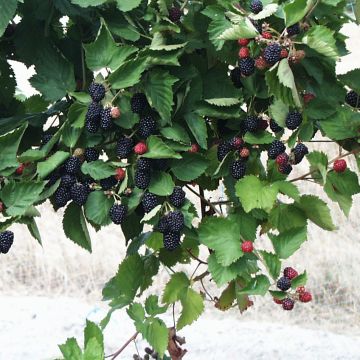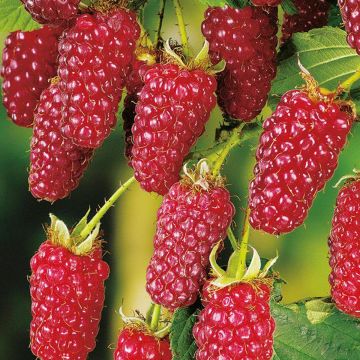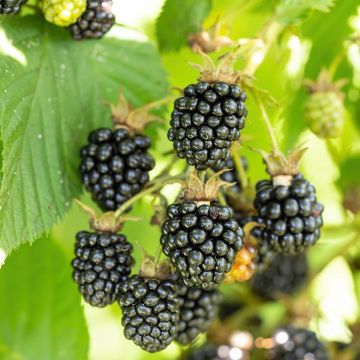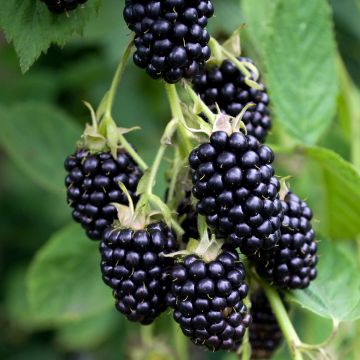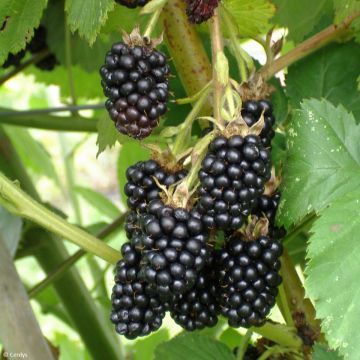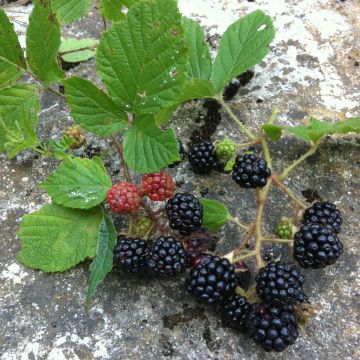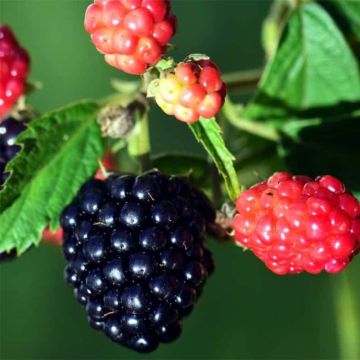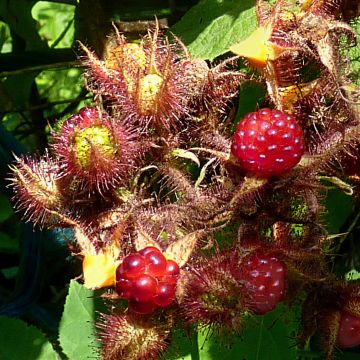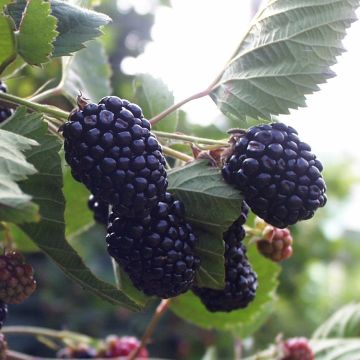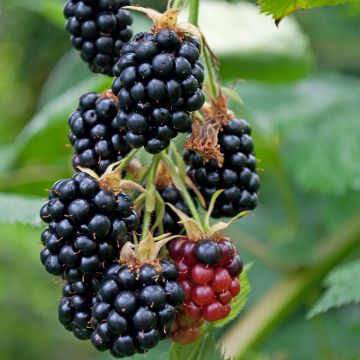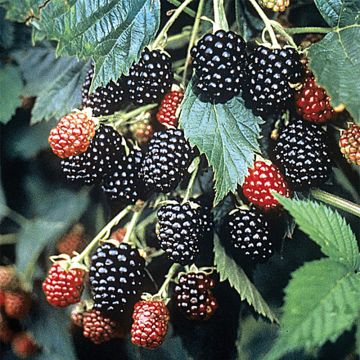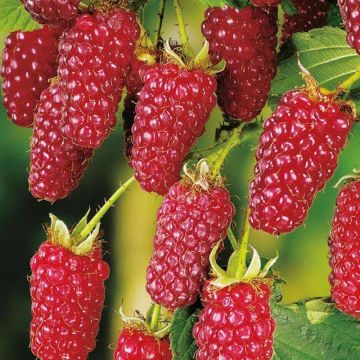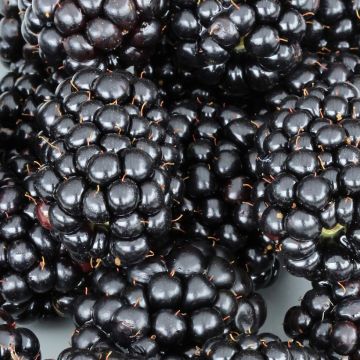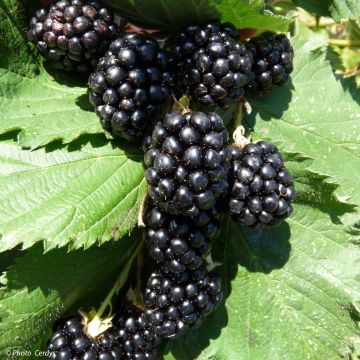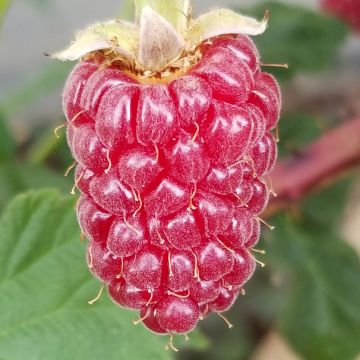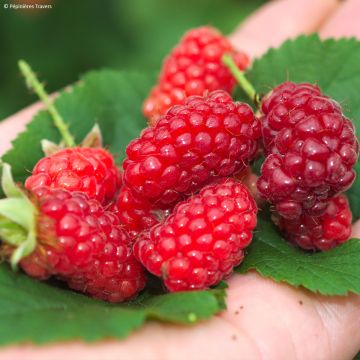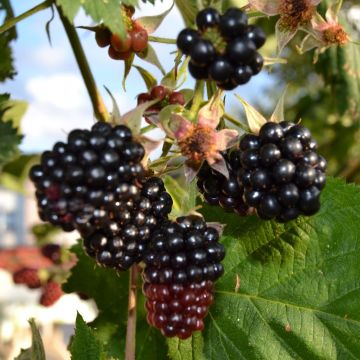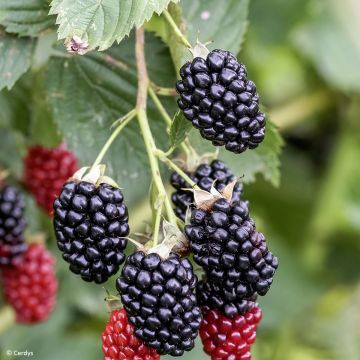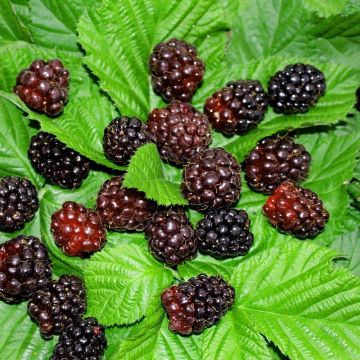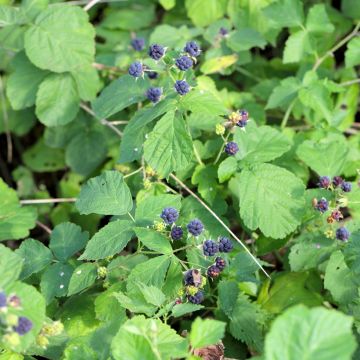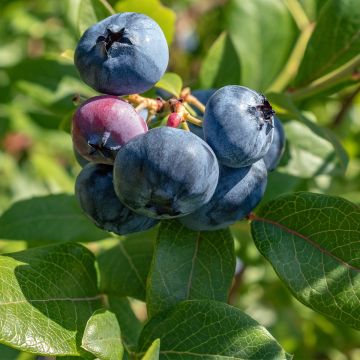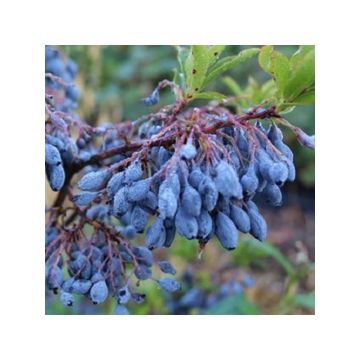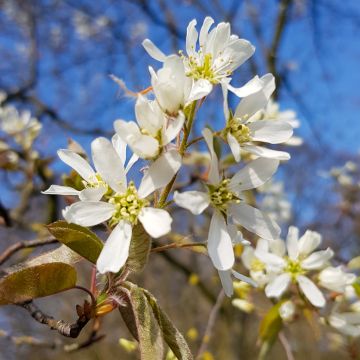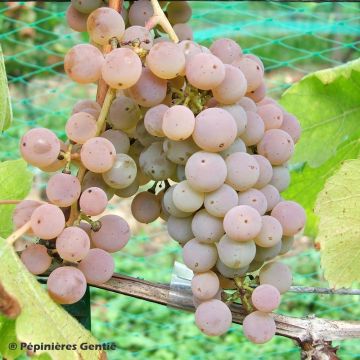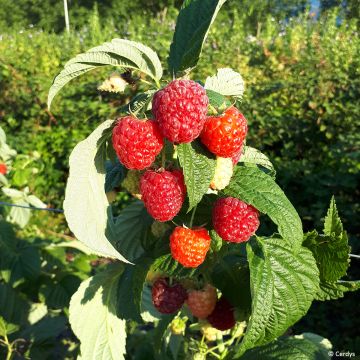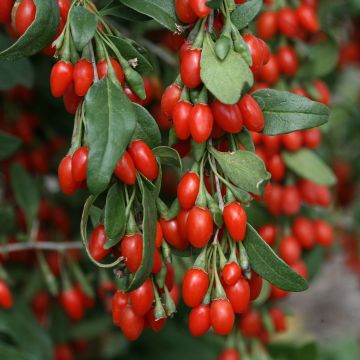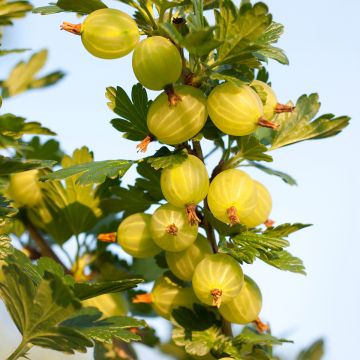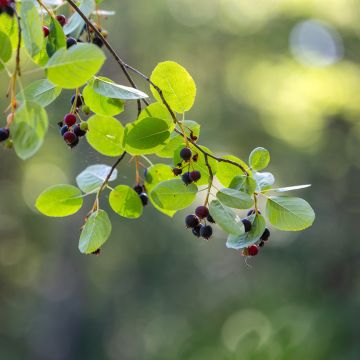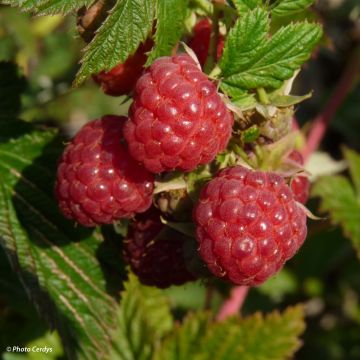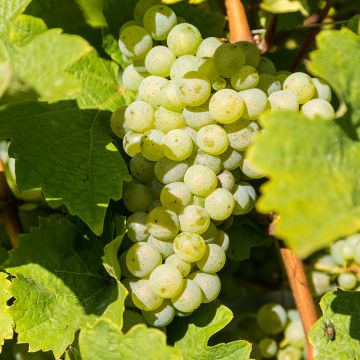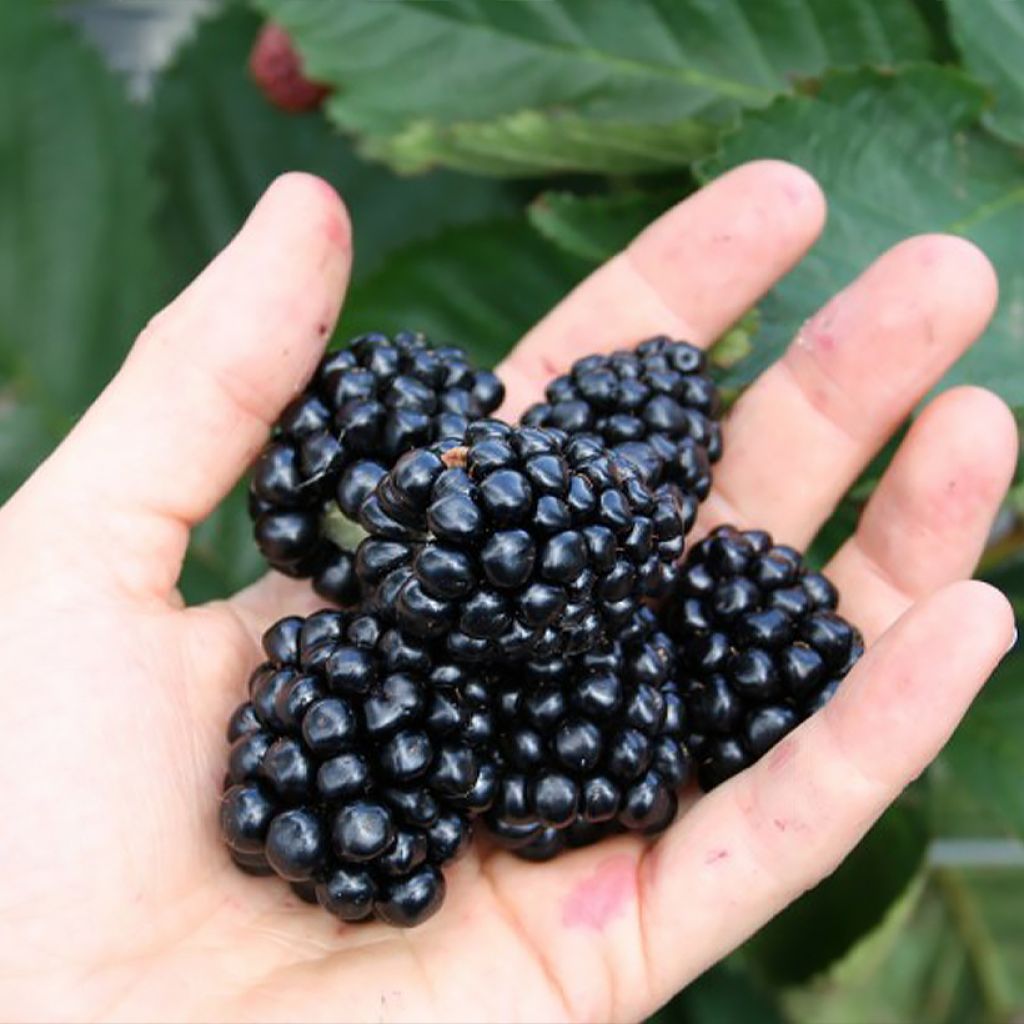

Mûre Direttissima Montblanc - Rubus fruticosus
Rubus fruticosus Direttissima Montblanc - Blackberry
Rubus fruticosus Direttissima® Montblanc®
Blackberry, Bramble
Why not try an alternative variety in stock?
View all →This plant carries a 6 months recovery warranty
More information
We guarantee the quality of our plants for a full growing cycle, and will replace at our expense any plant that fails to recover under normal climatic and planting conditions.
From €5.90 for pickup delivery and €6.90 for home delivery
Express home delivery from €8.90.
Delivery to Corse prohibited: UE law prohibits the import of this plant from mainland France to Corse as part of the fight against Xylella fastidiosa. Please accept our sincere apologies.
More information
Description
Rubus fruticosus 'Direttissima Montblanc' Garden Blackberry is a robust, hardy and very vigorous fruit undershrub, with semi-rigid thorny branches. In May-June, it produces small white melliferous flowers on the current year's shoots. Large black fruits follow the flowers. The fruits are juicy and delicious with a nice balance of sweet and tangy flavours. Very generous from mid-August to autumn, the fruits are a delight to enjoy fresh or in coulis, jellies, jams, pies, and fruit salads. Recommended planting in autumn or spring for regions with cold or humid winters.
Rubus belongs to the Rosaceae family. It is native to the mountains of the Caucasus in Asia Minor. This genus has diversified over time and has given rise to several subgenera, including the raspberry (Rubus idaeus) and the common blackberry (Rubus fruticosus). This latter genus has many subspecies with differences in size, colour, and acidity of the fruit. In Europe and America, this berry has been consumed for about 2000 years. Rubus fruticosus is more commonly known as bramble or wild blackberry. It is a climbing liana that can measure 5m (16ft) in width and more, with stems generally equipped with thorns. It is present in many temperate regions of the world, where it is often considered an invasive plant.
Rubus fruticosus 'Direttissima Montblanc’ is a climbing perennial plant with a semi-shrubby and bushy habit. The branches reach 2 to 3m (7 to 10ft) in length, and the stump can occupy 0.5 to 1m (2 to 3ft) on the ground. The foliage is deciduous, falling in autumn. It is bright green in colour, composed of small, cut and toothed leaves, with visible veins, very similar to raspberry leaves. The stems are thorny. Fruiting occurs on the current year's branches, so it is important to renew them each year by pruning the plant to 15cm (6in) above the ground. From the first year, from May to June, the abundant and melliferous flowering displays numerous small, white, single, cup-shaped flowers, 1.5 to 2 cm (1in) in diameter, grouped in clusters. The forming fruits are composed of drupes agglutinated to the receptacle. They are much larger than those of wild blackberries. They are red then black and shiny when ripe. They must be picked when fully black, when they are sweet and tangy, juicy and flavourful.
'Direttissima Montblanc' Blackberry fruits abundantly from mid-August to October, offering the advantage of a staggered harvest for many gustatory uses. The blackberry is a delicate fruit that must be carefully picked. Rinse with water and keep them in the refrigerator. Harvesting is easy and it is very enjoyable either to taste the fruits on the spot or to pick them for many culinary uses: jellies, jams, sorbets, coulis, syrups, juices, tiramisu, crumble, and puddings... not to mention the famous blackberry pie! Low in calories, but rich in minerals (manganese, iron, potassium), vitamins C and K, fibres, and antioxidants, the blackberry contributes to a good nutritional balance.
Hardy to -20°C (-4°F) and easy to grow, 'Direttissima Montblanc' Blackberry is satisfied with ordinary soil, with a preference for fertile, moist but well-drained soils. It is unnecessary to trellis it since at the end of winter, all the stems will be pruned to 15cm (6in) above the ground. A good mulching at the beginning of summer can be beneficial to prevent soil drying out.
Report an error about the product description
Plant habit
Fruit
Flowering
Foliage
Botanical data
Rubus
fruticosus
Direttissima® Montblanc®
Rosaceae
Blackberry, Bramble
Cultivar or hybrid
Other Blackberry bush
Planting and care
It prefers deep, fertile, and moist soils, but it is a low-maintenance plant that will adapt to any ordinary soil, as long as it is not too dry in summer. This bush fruits in the sun or partial shade. It will fruit in full shade, but the fruits will be of lower quality. In cool regions, it will tolerate full sun well. In hotter climates, it prefers partial shade. It is best to plant it in the garden in autumn, from September to December.
Dig a hole twice as large as the root system. Loosen the root ball with a slightly sharp tool to untangle the roots and promote growth. Place the bush in the hole without burying it too deep. Water well to compact the soil and remove air around the roots. Make sure the plant does not lack water during the first year after planting.
Regular watering is necessary to facilitate root establishment during the first year of planting. During periods of high heat or prolonged drought, provide additional water. Weed the surface, especially at the beginning of planting, and apply mulch to maintain moisture in summer.
Organic fertiliser is beneficial at the start of vegetation. Train the new branches as they grow to prevent overgrowth. It naturally propagates through layering, meaning that if a branch touches the ground for an extended period, it will develop roots and new shoots, creating a new bush.
During the first year, only keep the vigorous branches.
Planting period
Intended location
Care
This item has not been reviewed yet - be the first to leave a review about it.
Berries
Haven't found what you were looking for?
Hardiness is the lowest winter temperature a plant can endure without suffering serious damage or even dying. However, hardiness is affected by location (a sheltered area, such as a patio), protection (winter cover) and soil type (hardiness is improved by well-drained soil).

Photo Sharing Terms & Conditions
In order to encourage gardeners to interact and share their experiences, Promesse de fleurs offers various media enabling content to be uploaded onto its Site - in particular via the ‘Photo sharing’ module.
The User agrees to refrain from:
- Posting any content that is illegal, prejudicial, insulting, racist, inciteful to hatred, revisionist, contrary to public decency, that infringes on privacy or on the privacy rights of third parties, in particular the publicity rights of persons and goods, intellectual property rights, or the right to privacy.
- Submitting content on behalf of a third party;
- Impersonate the identity of a third party and/or publish any personal information about a third party;
In general, the User undertakes to refrain from any unethical behaviour.
All Content (in particular text, comments, files, images, photos, videos, creative works, etc.), which may be subject to property or intellectual property rights, image or other private rights, shall remain the property of the User, subject to the limited rights granted by the terms of the licence granted by Promesse de fleurs as stated below. Users are at liberty to publish or not to publish such Content on the Site, notably via the ‘Photo Sharing’ facility, and accept that this Content shall be made public and freely accessible, notably on the Internet.
Users further acknowledge, undertake to have ,and guarantee that they hold all necessary rights and permissions to publish such material on the Site, in particular with regard to the legislation in force pertaining to any privacy, property, intellectual property, image, or contractual rights, or rights of any other nature. By publishing such Content on the Site, Users acknowledge accepting full liability as publishers of the Content within the meaning of the law, and grant Promesse de fleurs, free of charge, an inclusive, worldwide licence for the said Content for the entire duration of its publication, including all reproduction, representation, up/downloading, displaying, performing, transmission, and storage rights.
Users also grant permission for their name to be linked to the Content and accept that this link may not always be made available.
By engaging in posting material, Users consent to their Content becoming automatically accessible on the Internet, in particular on other sites and/or blogs and/or web pages of the Promesse de fleurs site, including in particular social pages and the Promesse de fleurs catalogue.
Users may secure the removal of entrusted content free of charge by issuing a simple request via our contact form.
The flowering period indicated on our website applies to countries and regions located in USDA zone 8 (France, the United Kingdom, Ireland, the Netherlands, etc.)
It will vary according to where you live:
- In zones 9 to 10 (Italy, Spain, Greece, etc.), flowering will occur about 2 to 4 weeks earlier.
- In zones 6 to 7 (Germany, Poland, Slovenia, and lower mountainous regions), flowering will be delayed by 2 to 3 weeks.
- In zone 5 (Central Europe, Scandinavia), blooming will be delayed by 3 to 5 weeks.
In temperate climates, pruning of spring-flowering shrubs (forsythia, spireas, etc.) should be done just after flowering.
Pruning of summer-flowering shrubs (Indian Lilac, Perovskia, etc.) can be done in winter or spring.
In cold regions as well as with frost-sensitive plants, avoid pruning too early when severe frosts may still occur.
The planting period indicated on our website applies to countries and regions located in USDA zone 8 (France, United Kingdom, Ireland, Netherlands).
It will vary according to where you live:
- In Mediterranean zones (Marseille, Madrid, Milan, etc.), autumn and winter are the best planting periods.
- In continental zones (Strasbourg, Munich, Vienna, etc.), delay planting by 2 to 3 weeks in spring and bring it forward by 2 to 4 weeks in autumn.
- In mountainous regions (the Alps, Pyrenees, Carpathians, etc.), it is best to plant in late spring (May-June) or late summer (August-September).
The harvesting period indicated on our website applies to countries and regions in USDA zone 8 (France, England, Ireland, the Netherlands).
In colder areas (Scandinavia, Poland, Austria...) fruit and vegetable harvests are likely to be delayed by 3-4 weeks.
In warmer areas (Italy, Spain, Greece, etc.), harvesting will probably take place earlier, depending on weather conditions.
The sowing periods indicated on our website apply to countries and regions within USDA Zone 8 (France, UK, Ireland, Netherlands).
In colder areas (Scandinavia, Poland, Austria...), delay any outdoor sowing by 3-4 weeks, or sow under glass.
In warmer climes (Italy, Spain, Greece, etc.), bring outdoor sowing forward by a few weeks.

































